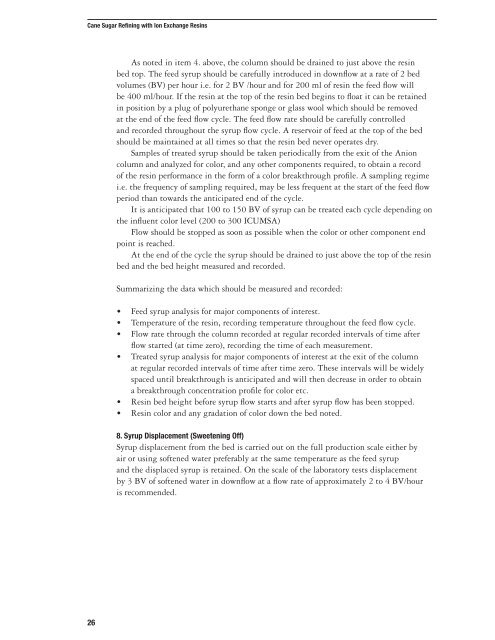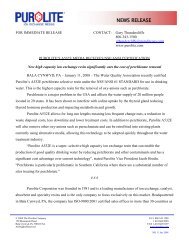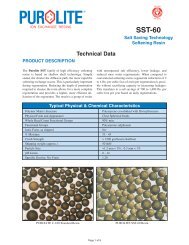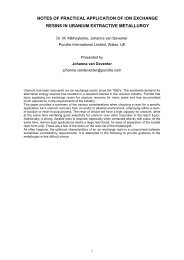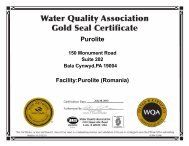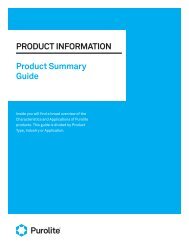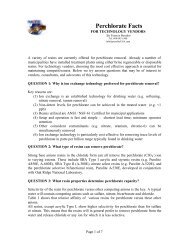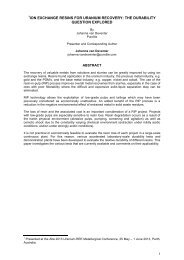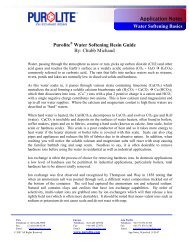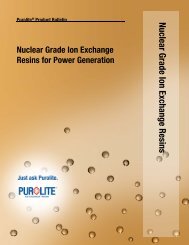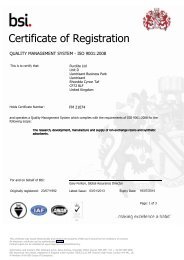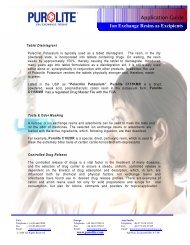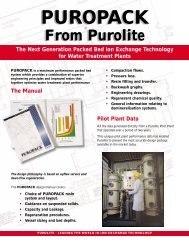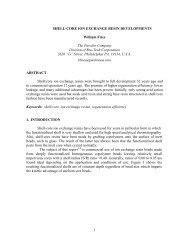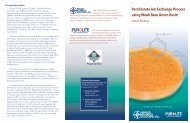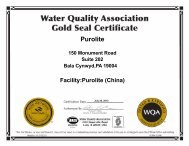Cane Sugar Refining - Purolite
Cane Sugar Refining - Purolite
Cane Sugar Refining - Purolite
Create successful ePaper yourself
Turn your PDF publications into a flip-book with our unique Google optimized e-Paper software.
<strong>Cane</strong> <strong>Sugar</strong> <strong>Refining</strong> with Ion Exchange Resins<br />
26<br />
As noted in item 4. above, the column should be drained to just above the resin<br />
bed top. The feed syrup should be carefully introduced in downflow at a rate of 2 bed<br />
volumes (BV) per hour i.e. for 2 BV /hour and for 200 ml of resin the feed flow will<br />
be 400 ml/hour. If the resin at the top of the resin bed begins to float it can be retained<br />
in position by a plug of polyurethane sponge or glass wool which should be removed<br />
at the end of the feed flow cycle. The feed flow rate should be carefully controlled<br />
and recorded throughout the syrup flow cycle. A reservoir of feed at the top of the bed<br />
should be maintained at all times so that the resin bed never operates dry.<br />
Samples of treated syrup should be taken periodically from the exit of the Anion<br />
column and analyzed for color, and any other components required, to obtain a record<br />
of the resin performance in the form of a color breakthrough profile. A sampling regime<br />
i.e. the frequency of sampling required, may be less frequent at the start of the feed flow<br />
period than towards the anticipated end of the cycle.<br />
It is anticipated that 100 to 150 BV of syrup can be treated each cycle depending on<br />
the influent color level (200 to 300 ICUMSA)<br />
Flow should be stopped as soon as possible when the color or other component end<br />
point is reached.<br />
At the end of the cycle the syrup should be drained to just above the top of the resin<br />
bed and the bed height measured and recorded.<br />
Summarizing the data which should be measured and recorded:<br />
•<br />
•<br />
•<br />
•<br />
•<br />
•<br />
Feed syrup analysis for major components of interest.<br />
Temperature of the resin, recording temperature throughout the feed flow cycle.<br />
Flow rate through the column recorded at regular recorded intervals of time after<br />
flow started (at time zero), recording the time of each measurement.<br />
Treated syrup analysis for major components of interest at the exit of the column<br />
at regular recorded intervals of time after time zero. These intervals will be widely<br />
spaced until breakthrough is anticipated and will then decrease in order to obtain<br />
a breakthrough concentration profile for color etc.<br />
Resin bed height before syrup flow starts and after syrup flow has been stopped.<br />
Resin color and any gradation of color down the bed noted.<br />
8. Syrup Displacement (Sweetening Off)<br />
Syrup displacement from the bed is carried out on the full production scale either by<br />
air or using softened water preferably at the same temperature as the feed syrup<br />
and the displaced syrup is retained. On the scale of the laboratory tests displacement<br />
by 3 BV of softened water in downflow at a flow rate of approximately 2 to 4 BV/hour<br />
is recommended.


